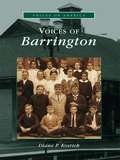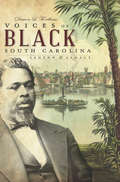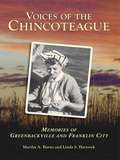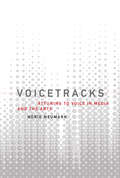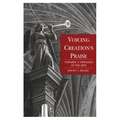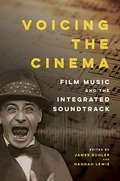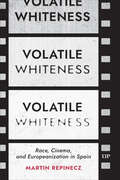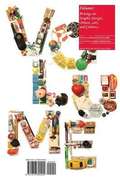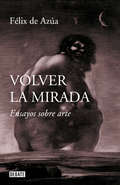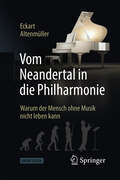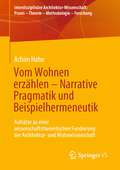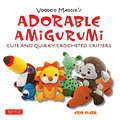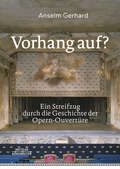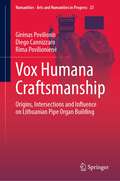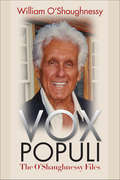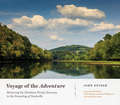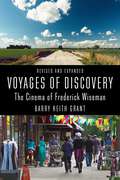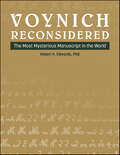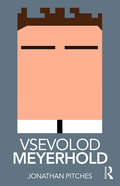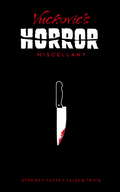- Table View
- List View
Voices of Barrington (Voices of America)
by Diane P. KostickOriginally settled by Irish, German, and English pioneers, the Barrington area has a long history of industrious and courageous citizens. In the early 1800s, these settlers laid the foundation for the Barrington of today: a colorful community beloved by residents and visitors. In a tribute to this town's heritage, Voices of Barrington profiles the people who have made-and who continue to make-Barrington a place rich with character and small-town charm. In this collection, the men and women who recount stories of times past and present offer a behind-the-scenes look at how they overcame obstacles and helped to shape their community. Readers discover that the barber down the street also struggled through the Great Depression, and that the brew-pub owner moved entire buildings in order to establish his business. Historic photographs from the Barrington Fire Department, library, daily newspaper, and the contributors' own family collections highlight the stories. The result is an intimate portrait of a typical-and extraordinary-American town.
Voices of Black South Carolina: Legend & Legacy (American Heritage)
by Damon L. FordhamDid you know that eighty-eight years before Rosa Parks's historic protest, a courageous black woman in Charleston kept her seat on a segregated streetcar? What about Robert Smalls, who steered a Confederate warship into Union waters, freeing himself and some of his family, and later served in the South Carolinastate legislature? In this inspiring collection, historian Damon L. Fordham relates story after story of notable black South Carolinians, many of whose contributions to the state's history have not been brought to light until now. From the letters of black soldiers during the Civil War to the impassioned pleas by students of "Munro's School" for their right to an education, these are the voices of protest and dissent, the voices of hope and encouragement and the voices of progress.
Voices of the Chincoteague: Memories of Greenbackville and Franklin City
by Martha A. Burns Linda S. HartsockBeginning around the turn of the 20th century, people flocked to boom towns like Greenbackville and Franklin City on Virginia's remote Chincoteague Bay to cash in on the lucrative oyster trade. Most eventually settled for simple rural lives, living a cash and barter economy, commuting on foot or by boat, always closely tied to the tide and water. From mystery in the marsh to jealous lovers, these accounts of life on the Bay are filled with work boats, crab pots, and saltwater.
Voicetracks: Attuning to Voice in Media and the Arts (Leonardo)
by Norie NeumarkThe affects, aesthetics, and ethics of voice in the new materialist turn, explored through encounters with creative works in media and the arts.Moved by the Aboriginal understandings of songlines or dreaming tracks, Norie Neumark's Voicetracks seeks to deepen an understanding of voice through listening to a variety of voicing/sound/voice projects from Australia, Europe and the United States. Not content with the often dry tone of academic writing, the author engages a “wayfaring” process that brings together theories of sound, animal, and posthumanist studies in order to change the ways we think about and act with the assemblages of living creatures, things, places, and histories around us.Neumark evokes both the literal—the actual voices within the works she examines—and the metaphorical—in a new materialist exploration of voice encompassing human, animal, thing, and assemblages. She engages with artists working with animal sounds and voices; voices of place, placed voices in installation works; voices of technology; and “unvoicing,” disturbances in the image/voice relationship and in the idea of what voice is. She writes about remixes, the Barbie Liberation Organisation, and breath in Beijing, about cat videos, speaking fences in Australia, and an artist who reads (to) the birds. Finally, she considers ethics and politics, and describes how her own work has shaped her understandings and apprehensions of voice.
Voicing Creation's Praise: Towards a Theology of the Arts
by Jeremy BegbieBegbie's unique background as a classically-trained musician and Cambridge theologian gives him wonderful insight and Spirit-led authority in dealing with this critical cultural topic. Moreover, Begbie breaks free of the Modernist stranglehold on aesthetic philosophy, and presents a refreshing and deeply Christocentric analysis of the relationship between the character and action of God and human creativity.
Voicing the Cinema: Film Music and the Integrated Soundtrack
by Hannah Lewis James BuhlerTheorists of the soundtrack have helped us understand how the voice and music in the cinema impact a spectator's experience. James Buhler and Hannah Lewis edit in-depth essays from many of film music's most influential scholars in order to explore fascinating issues around vococentrism, the voice in cinema, and music’s role in the integrated soundtrack. The collection is divided into four sections. The first explores historical approaches to technology in the silent film, French cinema during the transition era, the films of the so-called New Hollywood, and the post-production sound business. The second investigates the practice of the singing voice in diverse repertories such as Bergman's films, Eighties teen films, and girls' voices in Brave and Frozen. The third considers the auteuristic voice of the soundtrack in works by Kurosawa, Weir, and others. A last section on narrative and vococentrism moves from The Martian and horror film to the importance of background music and the state of the soundtrack at the end of vococentrism. Contributors: Julie Brown, James Buhler, Marcia Citron, Eric Dienstfrey, Erik Heine, Julie Hubbert, Hannah Lewis, Brooke McCorkle, Cari McDonnell, David Neumeyer, Nathan Platte, Katie Quanz, Jeff Smith, Janet Staiger, and Robynn Stilwell
Volatile Whiteness: Race, Cinema, and Europeanization in Spain (Toronto Iberic #94)
by Martin RepineczThe decades spanning from the 1960s to the 1980s in Spain were marked by a series of significant changes: a flourishing economy fuelled by tourism, widespread migration from rural areas to cities, the dissolution of the African empire, evolving gender and sexual norms, and a political transition from dictatorship to democracy. Volatile Whiteness argues that throughout this period, popular film genres such as comedies, crime thrillers, musicals, and religious cinema aimed to erode the racialized image of Spain as an "Africa of Europe" and establish the nation's belonging in global whiteness. The book explores how popular films shaped the attitudes of Spanish audiences towards racialized groups even before the onset of mass immigration in the 1990s and traces the construction of the Roma community as an internal threat to the nation’s upward mobility during late Francoism and the subsequent Transition. The book examines films that have retained popularity among contemporary Spanish audiences due to their continued circulation on television and other platforms. In doing so, Volatile Whiteness reflects not only on the meanings that popular films of the past may have had for their original audiences, but also on the ways they may shape the lived experiences of racial minorities in Spain today.
Volume
by Rudy Vanderlans Kenneth FitzgeraldVolume--a word that refers to sound, collections, and the measurement of space--is a crucial characteristic of both graphic design and popular music. While expressing different aspects of these two pervasive cultural mediums, the term also introduces a discussion on their many links. Volume: Writings on Graphic Design, Music, Art, and Culture is a collection of both new and classic writings by frequent Emigre contributor and educator Kenneth FitzGerald that survey the discipline of graphic design in context with the parallel creative fields of contemporary music and art. The topics of the writings are diverse: the roles of class in design, design education, Lester Bangs and Creem magazine, pornography, album cover art, independent record labels, anonymity and imaginary creative identities, and design as cultural chaos-maker.
Volver la mirada: Ensayos sobre arte
by Félix De AzúaUno de los ejercicios de crítica artística más inteligentes, detallados e iluminadores de nuestro tiempo. En Volver la mirada, Félix de Azúa reúne todos los ensayos sobre pintura y arquitectura que ha escrito en los últimos veinte años, un recorrido interpretativo, siempre ambicioso, ameno e ilustrativo, que va desde la pintura rupestre y el arte clásico hasta la crisis del romanticismo, las vanguardias y el problema del arte contemporáneo, lo que se ha llamado filosóficamente «el arte después del arte». Con una gran capacidad analítica y comparativa, Azúa medita en torno al enigma de lo que llamamos Arte, las pruebas de cuyos orígenes se encuentran en las cuevas paleolíticas. Asimismo, el autor concentra su atención en la eclosión del romanticismo -en Goya, Delacroix, en la invención moderna del paisaje-, preludio de las vanguardias que empiezan con Manet y Cézanne y siguen con Degas o Picasso hasta llegar a la abstracción de Kandinsky y la «muerte del arte», con la coda postmuseística de los happenings o el Land Art.
Volver la mirada: Ensayos sobre arte
by Félix de AzúaUno de los ejercicios de crítica artística más inteligentes, detallados e iluminadores de nuestro tiempo. En Volver la mirada, Félix de Azúa reúne los ensayos sobre pintura y arquitectura que ha escrito en los últimos veinte años, alguno de ellos inéditos hasta el momento. Desde la pintura rupestre y el arte clásico hasta la crisis del romanticismo, las vanguardias y el problema del arte contemporáneo, o lo que se ha denominado filosóficamente «el arte después del arte», he aquí un recorrido interpretativo, ambicioso, ameno e ilustrativo, de un gran intelectual que medita en torno al enigma de lo que llamamos Arte. «Para mí, y creo que, para todos nosotros, ha llegado el momento de volver la mirada sobre nuestros antepasados para acercarnos a su sabiduría [...] El mundo entero está en una situación de extremo peligro y la sabiduría de los muertos nos hace mucha falta. Ojalá mis torpes aproximaciones sirvan para algo.»Félix de Azúa
Vom Neandertal in die Philharmonie: Warum der Mensch ohne Musik nicht leben kann
by Eckart AltenmüllerWarum haben wir Menschen Musik? Wie entfaltet Musik ihre Wirkung? Was geht dabei in unserem Gehirn vor? Fördert Musik die Intelligenz? Dient sie dem Gruppenzusammenhalt? Teilt Musik Emotionen mit? Dieses Buch erklärt die zahlreichen Wirkungen von Musik auf Fühlen und Denken, auf die Organisation von Gruppen sowie auf unsere körperliche und geistige Gesundheit. Im ersten Teil des Werkes werden die evolutionären Grundlagen der Musikwahrnehmung und des Musizierens dargestellt. Die faszinierenden neuen Erkenntnisse zu den positiven, aber auch den negativen Auswirkungen intensiven Musizierens auf das Nervensystem werden in den folgenden Kapiteln geschildert. Glücklicherweise macht Musik nur selten krank – viel wichtiger sind die bislang noch gar nicht ausgeschöpften heilenden Potenziale und die große Macht der positiven Emotionen, die durch Musik ausgelöst werden. Mit diesen erfreulichen und zukunftsweisenden Aspekten schließt das Buch, das jeden ansprechen wird, der eine Liebe zur Musik empfindet, sei es als Musizierender oder als Hörer.
Vom Wohnen erzählen – Narrative Pragmatik und Beispielhermeneutik: Aufsätze zu einer wissenschaftstheoretischen Fundierung der Architektur- und Wohnwissenschaft (Interdisziplinäre Architektur-Wissenschaft: Praxis – Theorie – Methodologie – Forschung)
by Achim HahnDie Beiträge dieses Bandes vereinigen in sich die Aufgabe, ein überzeugendes und kritisches wissenschaftliches Konzept vorzulegen, das aussichtsreich und nachvollziehbar Bedingungen formuliert und Möglichkeiten aufzeigt, den „komplexen Sitz“ einer beherbergenden Architektur im Leben methodisch kontrolliert zu erkunden.
Voodoo Maggie's Adorable Amigurumi
by Erin ClarkVoodoo Maggie knows cute and these are possibly the cutest creatures that can be created with colored yarn. There are adorable Koala Bears, Darling Dachshunds, Snuggly Bats, and the not-very-fearsome but actually-kinda-cute Yeti. In Voodoo Maggie's Adorable Amigurumi, there are 18 creatures that Voodoo Maggie is willing to unleash on a world yearning for some serious cuteness. Full of colorful photos to help guide you through the patterns, this book has projects even beginners can complete in a weekend or less. Some can be done in a day! All the knitting instructions and step-by-step illustrations are provided so you can coax this marvelous menagerie into cuddly reality.
Vorhang auf?: Ein Streifzug durch die Geschichte der Opern-Ouvertüre
by Anselm GerhardDie Ouvertüre gehört zur Oper wie der Spitzenton in der höchsten Sopran- oder Tenor-Lage. Sollte man meinen. Dabei beginnt längst nicht jede Oper mit einer Ouvertüre. Dieses Buch beschreibt Erscheinungsformen und Funktionen der instrumentalen Einleitung im Musiktheater vom Barock bis in die Moderne. Der Blick ist dabei auf den Zusammenhang zwischen Eröffnungsmusik und Bühnenhandlung gerichtet, auf etwas, was in der Frühzeit der Oper gerade nicht angestrebt worden war, sich dann aber Schritt für Schritt entwickelte. So erzählt das Buch viele unbekannte Geschichten von konventionellen und vor allem unkonventionellen Lösungen, wie eine Oper eröffnet und ein Publikum zur Aufmerksamkeit gerufen wurde. Schon im 18. Jahrhundert gab es beispielsweise Pantomimen bei geöffnetem Vorhang – und zwar lange bevor ‚moderne‘ Opernregie solche Aktionen traditionellen Ouvertüren hinzuerfinden sollte. Auch davon ist, in einem Bogen von Monteverdis „Orfeo“ bis zu Brittens „Owen Wingrave“, die Rede.
Votive Panels and Popular Piety in Early Modern Italy
by Fredrika H. JacobsIn the late fifteenth century, votive panel paintings, or tavolette votive, began to accumulate around reliquary shrines and miracle-working images throughout Italy. Although often dismissed as popular art of little aesthetic consequence, more than 1,500 panels from the fifteenth and sixteenth centuries are extant, a testimony to their ubiquity and importance in religious practice. Humble in both their materiality and style, they represent donors in prayer and supplicants petitioning a saint at a dramatic moment of crisis. In this book, Fredrika H. Jacobs traces the origins and development of the use of votive panels in this period. She examines the form, context, and functional value of votive panels, and considers how they created meaning for the person who dedicated them as well as how they accrued meaning in relationship to other images and objects within a sacred space activated by practices of cultic culture.
Votre esthétique : utilisés par les mannequins
by James AbbottNe vous fatiguez pas avec des relookings coûteux qui prennent du temps ! Dans ce guide, vous apprendrez les astuces les plus efficaces et les moins coûteuses pour vous transformer en mannequin ! Ces méthodes sont couramment utilisées par les plus grands mannequins du monde et peuvent être appliquées même par une novice en quelques minutes seulement. Voici le contenu qui est inclus : - Des astuces simples - Des méthodes à faible coût - L’application rapide de maquillage en quelques minutes - Avoir l'air d'un mannequin - Le meilleur maquillage pour toute application
Vought F4 Corsair: Carrier and Land-Based Fighter (Profiles of Flight)
by Martin W. Bowman Dave WindleThe Vought F4U was the best carrier based fighter of WW2. 12,571 aircraft were built and downed 2,140 enemy aircraft for the loss of only 189 Corsairs. It was developed early in 1938 for the US Navy. The designer, Tex Beisel, worked on the principle of the largest engine in the smallest airframe. Britain received 2012 of the type. This book contains the world famous color profiles created by Dave Windle of the type in different operational modes, configurations and color schemes. Martin Bowman has written detailed descriptions and photographs to create the perfect enthusiasts reference.
Vox Humana Craftsmanship: Origins, Intersections and Influence on Lithuanian Pipe Organ Building (Numanities - Arts and Humanities in Progress #23)
by Rima Povilionienė Girėnas Povilionis Diego CannizzaroThis book provides a thorough analysis focused on the sound expression produced by human-crafted musical instrument – a pipe organ, in which various components blend into a complex whole to produce a wide range of timbres. The sound produced by wooden and metal pipes of a variety of sizes is an integral part of the instrument’s unique character, while the organ stop is like its signature, from which one can judge about the size and style of the instrument, an organ building school or even an organ master, to which it is attributable. Precise identification of the name of the stop in accordance to both the pipework itself and the authentic inscriptions on the pipes is instrumental in investigating the geographic origins and authorship of an organ. The monograph focuses on the craftsmanship of complex and historically influential organ stop Vox humana. Its research and definition provides specific information distinguishing particular features in the variety of organ building traditions and discussing the differences in organ sound perception and production. The volume is aimed at art and music historians, as well as musicologists and scholars researching restoration techniques.The book contains supplemental material with video and audio material as well as photo-documentation of authentic Vox humana examples. The material is placed in the online catalog, which may be accessed by scanning the QR code in the appendix of the book.dsgdsgds
Vox Populi: The O'Shaughnessy Files
by William O'ShaughnessyVox Populi is the long-awaited fourth collection of interviews, editorials, essays, observations and keen insight from legendary New York broadcaster William O’Shaughnessy. With this inspiring new anthology, Bill is back in a big way, offering compelling dialogue and opinion on timely issues and current events in politics, media, the arts and popular culture.A masterful interviewer, O’Shaughnessy goes one-on- one with Barbara Taylor Bradford, Steve Forbes,Joe Califano and a colorful band of townie characters from Westchester – the Golden Apple. Broadcastingfor five decades from what the Wall Street Journal hailed as “the quintessential community station inAmerica,” his thoughtful and muscular commentaries have been widely praised in all the important journalsin the land.A self-styled First Amendment “voluptuary,” O’Shaughnessy is a stellar defender of Free Speech,having devoted the good part of fifty years to fighting censorship and government intrusion from his influentialperch in the heart of the Eastern Establishment.He’s the one they roll out when the likes of Howard Stern, Bob Grant and Imus get in a jam. Colorful national figures and beguiling “townies” abound in Vox Populi which is also laden with exquisitely beautiful eulogies and tributes to his departed friends Tim Russert, Wellington Mara, Robert Merrill and Ossie Davis.And, as in every Bill O’Shaughnessy book, there is stunning and powerful wisdom and brilliant observationsfrom Governor Mario Cuomo whom he so admires.The great American historian David McCullough observed: “I always look forward to reading the historyof our times Bill O’Shaughnessy has written.” O’Shaughnessy is an authentic American voice.
Voyage créatif à travers Paris (Livres anti-stress créatifs #4)
by Olga Kryuchkova Elena KryuchkovaCe livre créatif est dédié aux types de merveilleuses villes françaises de Paris. Lorsque vous peignez, vous pouvez vous orienter vers l'échantillon de couleur, ou vous pouvez choisir les solutions de couleur pour la peinture. Après cela, vous serez fasciné de regarder dans les photos Internet des vues réelles de Paris, données dans ce livre. Le livre vous permettra de vous engager dans la créativité, de faire mentalement un voyage passionnant à Paris et d'apprendre de nouvelles informations. Toutes les images de ce livre sont basées sur des photographies des ressources libres de l'accès à Internet.
Voyage of the Adventure: Retracing the Donelson Party's Journey to the Founding of Nashville
by John GuiderIn the harsh winter of 1779, as the leader of a flotilla of settlers, John Donelson loaded his family and thirty slaves into a forty-foot flatboat at the present site of Kingsport, Tennessee. Their journey into the wilderness led to the founding of a settlement now known as Nashville—over one thousand river miles away. In the fall of 2016, photographer John Guider retraced the Donelson party's journey in his hand-built fourteen-and-a-half-foot motorless rowing sailboat (named Adventure II after Donelson's boat) while making a visual documentation of the river as it currently exists 240 years later. This photo book contains more than 120 striking images from the course of the journey, allowing the reader to see how much has changed and how much has remained untouched in the two and a half centuries since Donelson first took to the water. Equally significant, the essays include long-ignored contemporary histories of both the Cherokee whom Donelson encountered and the slaves he brought with him, some of whom did not survive the journey. From his platform just a few feet above the waterline, Guider, a professional photographer, created images of the thousand-mile trip along three of Tennessee's most notable rivers.
Voyages of Discovery: The Cinema of Frederick Wiseman (Nonfictions)
by Barry Keith GrantFrederick Wiseman is America’s foremost chronicler of public institutions. His films have focused on city, state, and local governments; hospitals; asylums; creative organizations and museums; schools; libraries; and more. In recent years, Wiseman’s work has reached a new level of popularity, with films such as In Jackson Heights (2015), Monrovia, Indiana (2018), and City Hall (2020) all earning widespread acclaim.Voyages of Discovery is the definitive account of Wiseman’s career, offering a comprehensive analysis of the work of the leading documentary filmmaker in the United States. In this updated edition, Barry Keith Grant adds new material exploring the documentarian’s works since the 1990s, discussing every film in Wiseman’s remarkable sixty-year career. He examines the core concerns running across Wiseman’s work from the early films, which focus on documenting institutional failure, through an expanding interest in cultural institutions and ideology, to a blossoming embrace of democracy in later films. He pays particular attention to Wiseman’s strategies for involving and implicating the spectator in the institutional processes the films document. Grant also places Wiseman within the history of the documentary and other traditions of American art and considers the relationship between documentary film and authorship. Voyages of Discovery is an important book for anyone interested in Wiseman’s work or how documentary film can reveal the fabric of our shared civic life.
Voynich Reconsidered: The Most Mysterious Manuscript in the World
by Robert H. EdwardsIn this book, Dr. Robert Edwards brings a fresh, mathematical perspective to the Voynich manuscript and sets out a strategy whereby the interested reader could extract meaning from the seemingly impenetrable symbols . . . if meaning is there to be found. The Voynich manuscript has been described as the most mysterious document in the world. In 1637, a Bohemian scholar sent a mysterious manuscript to the celebrated professor Athanasius Kircher in Rome. Kircher promised to decipher it when the mood took him. He never did. Later, antiquarian bookseller Wilfrid Voynich claimed that he had discovered it in 1912 in a castle in Europe. • Contains hundreds of bizarre illustrations that seem to represent plants, stars, animals, zodiac signs, strange receptacles, and naked women in pools and streams of green water. • Throughout its over 200 pages are strings of glyphs or symbols that look like words; but the symbols do not belong to any known living or extinct languages. • No one knows what these symbols mean—or even whether they mean anything, though hundreds of scholars have tried to decipher them for 500 years. • Today, all that we know for sure is that the parchment probably dates from the early 15th century.
Vsevolod Meyerhold (Routledge Performance Practitioners)
by Prof Jonathan PitchesVsevolod Meyerhold considers the life and work of the extraordinary twentieth-century director and theatre-maker. This compact, well-illustrated volume includes: a biographical introduction to Meyerhold’s life a clear explanation of his theoretical writings an analysis of his masterpiece production Revisor, or The Government Inspector a comprehensive and usable description of the ‘biomechanical’ exercises he developed for training the actor. As a first step towards critical understanding, and as an initial exploration before going on to further, primary research, Routledge Performance Practitioners offer unbeatable value for today's student.
Vuckovic's Horror Miscellany: Stories * Facts * Tales & Trivia
by Jovanka VuckovicFrom 'Frankenstein' and 'Dracula' to 'Night of the Living Dead' and 'The Omen', this grisly grimoire conjures up ghouls, demons and all manner of things that go bump in the night. Crammed with endless facts, trivia, and stories about every aspect of horror-from 1950s EC Comics and TV series 'The Twilight Zone'; to the music of Black Sabbath and Japanese horror films-this little gem of spookiness is guaranteed to keep readers up all night. Intriguing insights into the lives and work of classic horror writers like H.P. Lovecraft, Edgar Allan Poe, Clive Barker, and Stephen King are complemented by fascinating behind-the-scenes peeks into the productions of 'Psycho', 'The Thing', and 'Halloween'.Vuckovic's many authoritative lists include: The Top 13 Vampire Films; Scariest Horror Video Games; and The Best Horror Movie Taglines: " The good news is your date is here! The bad news is ... he's dead!" revealing humor in the horror.'Vuckovic's Horror Miscellany' is the ideal present for 'The Walking Dead' and 'World War Z' fan in your life. Just don't read it alone!
